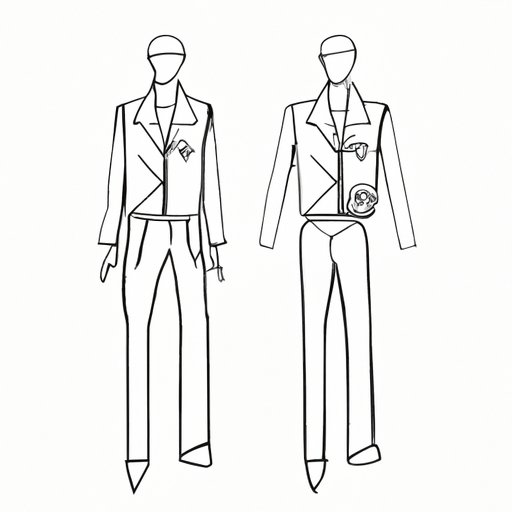
Introduction
Drawing a shirt can seem like a daunting task for beginners, but with this step-by-step guide, you’ll be able to create realistic and unique shirt designs in no time. This article is designed for anyone who wants to learn how to draw a shirt, whether you’re an aspiring artist or simply looking for a fun new hobby.
In this article, we’ll cover everything from basic shapes and techniques to more advanced tips for capturing different styles and fabric textures. We’ll also provide sample sketches to help illustrate each point.
Step-by-step Guide to Drawing a Basic T-shirt
Before we can get started on drawing different styles and fabric textures, it’s important to first master the basics. Here’s how to draw a basic t-shirt:
First, start by drawing a rectangle with rounded edges for the body of the shirt. This will be the base of our t-shirt design. Then, draw two smaller rectangles on either side of the body for the sleeves.
Next, add detail to the neck of the t-shirt by extending two lines upwards from the top of the rectangle. This will form the base of the collar. From here, draw another line across the top of the collar to complete it.
Finally, add details like stitching and shading to your t-shirt to make it look more realistic. You can also experiment with different colors and designs to make your shirt unique.
Capturing Different Styles of Shirts
Now that you’ve mastered the basic t-shirt design, it’s time to start experimenting with different styles. Some popular t-shirt styles include the polo shirt, long sleeve shirt, and button-up shirt.
To capture the unique shape of each style, pay close attention to elements like collar shape, sleeve length, and overall fit. For example, a polo shirt typically has a two or three-button placket and a collar that lays flat, while a long sleeve shirt features longer sleeves that extend past the wrists.
To help illustrate the differences between each style, we’ve included sample sketches of each one.
Tips and Tricks for Drawing Realistic Fabric Textures
One of the keys to drawing a realistic shirt is capturing the texture of the fabric. To do this, focus on areas where the fabric would naturally bunch or bunch up, creating wrinkles and folds.
One technique for creating these folds is to use crosshatching or shading to suggest the folds in the fabric. You can also make use of shadows and highlights to give depth to the fabric texture.
To help you master these techniques, we’ve included sample sketches that showcase different fabric textures.
The Importance of Sketching When Learning to Draw a Shirt
Sketching is an essential part of the drawing process, especially when it comes to learning how to draw a shirt. By creating rough drafts or sketches, you can experiment with different designs and techniques before finalizing your drawing.
When refining your sketch into a finished piece, pay close attention to elements like proportion, shading, and texture. These details will help bring your drawing to life.
Tutorial on Drawing T-shirts on Human Figures
Once you’ve mastered drawing basic t-shirts, it’s time to start incorporating them into your drawings of human figures. When drawing t-shirts on figures, pay attention to how the fabric falls and drapes over different parts of the body.
To help you get started, we’ve included a tutorial on proper human figure proportions and positioning, as well as tips for accurately representing the way cloth falls and drapes over various parts of the figure.
Inspirational Showcase of Shirt Drawing Styles
Looking for inspiration for your next shirt design? Check out our showcase of different interpretations and styles of shirt drawings from artists around the world. From bold patterns and unique designs to more subtle styles, there’s something here for everyone.
Take note of the different approaches and techniques used by each artist, and use them to inspire your own shirt designs.
Conclusion
Drawing a shirt may seem challenging at first, but with practice and experimentation, anyone can learn to master this skill. By starting with a basic t-shirt design and building on that foundation, you’ll soon be creating unique and realistic shirt designs of your own.
Remember to pay close attention to details like fabric texture, fit, and style, and don’t be afraid to experiment with new techniques and styles. With time and patience, you’ll soon be creating beautiful shirt designs that you can be proud of.





